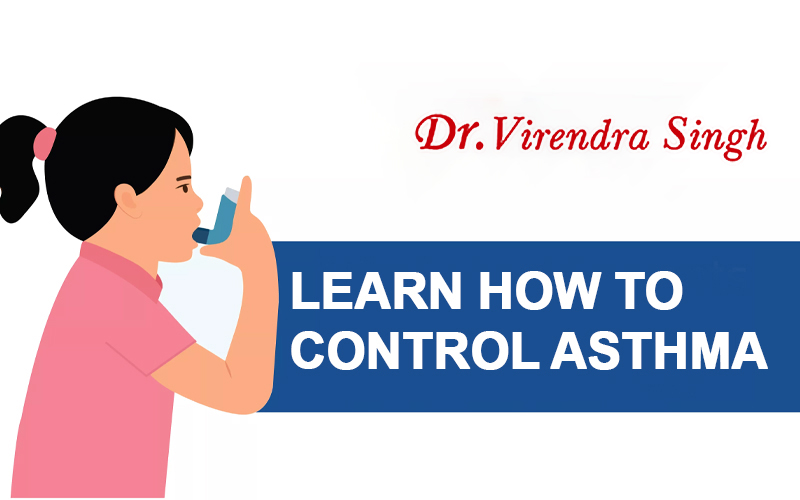
Learn How To Control Asthma: Asthma is a prevalent long-term lung disease that may occur across the ages or stages of life. It results in the airways of the lungs getting inflamed and narrowed, which in turn causes cough, wheeze, chest tightness, and difficulty breathing. Fortunately, although asthma is incurable, its symptoms are typically easy to manage by avoiding triggers, using one’s prescribed inhalers as directed by the doctor, and following other medical instructions. It gives a chance where your life is not derailed daily.
How Can You Tell If You Have Asthma?
Given that asthma lacks confirmatory visible features or testing that proves an absolute diagnosis, physicians deduce likelihood through detailed history-taking and breathing assessments. They analyze:
- Chronicity of coughing, chest tightness, and audible wheezing
- Timing associations linking symptoms to potential triggers like exercise, allergen exposures, or weather
- A family history of atopy or asthma suggests genetic risk
- Past evidence of related conditions like eczema or environmental allergies
- Ability to maintain airflow during specialized breathing evaluations
- Symptom responses to diagnostic bronchodilator and anti-inflammatory medications
Tips to Control Asthma
Proper medication and lifestyle changes are essential for managing and dealing with asthma. Therefore, here are simple guidelines to make your life easier.
-
Identify and Avoid Your Asthma Triggers
Asthma “attacks” or flare-ups result from contact with triggering irritants, sparking allergic inflammation or airway spasms for people susceptible. Learning your specific triggers is crucial, avoiding episodes through strategic avoidance when possible.
Common asthma triggers include:
- Cold dry air
- Respiratory infections
- Exercise
- Air pollutants
- Smoke
- Pollens
- Pet dander
- Mold
- Dust mites
- Strong fragrances
A symptom diary noting activities, locations, and exposures before onset helps uncover your triggers. Share revelations with your doctor to create avoidance strategies to minimize future risk.
-
Using Controller and Rescue Inhalers
Inhaled corticosteroid controller meds are cornerstones of proper asthma management. They are taken daily to prevent attacks by reducing airway inflammation. Always take them, even when feeling well.
Quick-relief rescue inhalers like albuterol open constricted airways quickly relieving acute wheezing and shortness of breath. Carry these in case of exposure to unavoidable triggers. Avoid over-dependence, indicating worsening control needing medical change.
Spacer devices maximize medicine delivery to the lungs rather than simply the mouth. Rinsing the mouth after prevents side effects like thrush.
-
Monitoring Lung Function
Measurement of exhalation flow rates at their peak aids in determining lung capacity and asthma control when they are more than 80% between flareups. A value lower than 60% indicates that the blood sugar level worsens. This demands immediate medication increments and rapid-acting insulin, thereby preventing the case from worsening to the point of hospitalization.
Most doctors normally provide patients with peak flow meters at home. The lung’s status is tracked. The medications are changed, and the drugs’ effectiveness is recorded. Finally, the right drugs are decided upon.
-
Creating an Asthma Action Plan
Work closely with your doctor to create a personalized written asthma action plan including:
- Your daily controller medicine list noting proper dosage timing
- Quick-relief inhaler instructions explaining prescribed usage frequency
- Lung function monitoring instructions and zone ratings
- Specific steps to take if readings drop into more concerning lower percentage zones
- Warning signs and health contacts for medical assistance if peak flows continue deteriorating into emergency zones
Share copies of completed plans with family members, school health staff, and coaches, enabling proper support in recognizing and responding to worsening symptoms.
-
Avoiding Asthma Complications
While chronic, controlled asthma needn’t limit activities with proper management, complications do occasionally occur after peak flow readings languish unattended below critical thresholds. Warning signs include:
- Little to no air movement felt when taking rescue inhaler breaths
- Blue tingeing of nails and lips from oxygen deprivation
- Chest pain or tightness worsening
- Hunched shoulders and contracted neck muscles, trying harder to breathe
Rapid breathing exceeding 30 breaths per minute signals likely respiratory failure without swift intervention. Seek immediate medical assistance if symptoms fail to improve after repeated rescue inhaler doses. Don’t downplay or normalize increasingly frightening breathing experiences. Overwhelmed airways require urgent expert care to prevent grave consequences. Early hospital treatments rapidly alleviate crises through oxygen, fluids, and intravenous corticosteroid injections, calming swollen passages.
-
Get Vaccinated Against Infection Triggers
Catching a bad cold or the flu almost always worsens asthma, coughing, and wheezing for days or weeks. That’s why getting all recommended viral infection vaccination shots can help prevent asthma flare-up disasters. Ask your doctor about flu shots every fall. Also, discuss pneumonia vaccines and Tdap boosters that protect against other germs that stir up lung inflammation on top of asthma. Avoiding the miseries of respiratory illness through key vaccinations is vital to keeping chronic asthma under better control.
Conclusion
People achieve fulfilling, active lives despite chronic asthma by identifying asthma triggers, properly using prescribed inhalers, tracking peak flow readings, and communicating about changes early. Partner closely with experienced specialist Dr. Virendra Singh, optimizing control through personalized plans, and balancing lifestyle accommodations and medication. Breathe easier.
